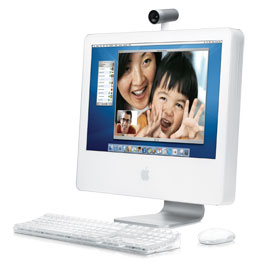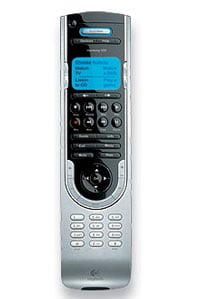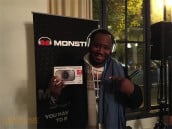Find Our Latest Video Reviews on YouTube!
If you want to stay on top of all of our video reviews of the latest tech, be sure to check out and subscribe to the Gear Live YouTube channel, hosted by Andru Edwards! It’s free!
Latest Gear Live Videos
Best EVDO Card for Mac PowerBooks?

Posted by Andru Edwards Categories: PC / Laptop, Peripherals, Wireless / WiFi,
 Om Malik has given a bit of advice to those looking for some EVDO love on their PowerBooks:
Om Malik has given a bit of advice to those looking for some EVDO love on their PowerBooks:
If you are looking for a EVDO card for Powerbook, I will recommend, Sierra Wireless Aircard 580, which after some hacking gives you better performance than any other PC card. However, it doesn’t work as well with Windows Laptops. It was giving me about 350 kbps on Mac and 115 kbps on a PC laptop. Novatel’s Merlin v620, however is a solid and brisk performer on Windows Machines, with average speed of about 270 kbps. It got 115-120 kbps on a Mac. The comparisons were carried out using Powerbook 15 (Tiger) and Averatec 1000. I sat in the same location for the two laptops, and repeated this experiment in four different spots in San Francisco. I look forward to your feedback from other cities. Kyocera 650 is known to work well with a Mac. Folks over at EVDOinfo.com have more details. These recommendations are only for Verizon’s EVDO service only.
Mike from EVDOinfo.com chimes in:
Did you run your tests more than once? We have found the KPC650 to be the best performer out of the 5 EVDO cards that are currently available. The KPC650 is the only card that Verizon supports on Macs, although, at http://www.EVDOinfo.com, you will find directions to get ALL cards working with PowerBooks for Verizon or Sprint.
Anyone out there have any personal recommendations, or horror stories?
(Thanks Doug!)
Read More  | GigaOm
| GigaOm
Gallery: Best EVDO Card for Mac PowerBooks?
Advertisement
Researchers Decode Messages By Analyzing Typing Sounds
Posted by Devin Categories: Misc. Tech, Peripherals,
 Is it possible to transcribe what others are typing simply by the listening to the noise their keystrokes make? According to Doug Tygar of the University of California, Berkeley, the answer is yes. Tygar and his colleagues recorded 10 minutes worth of typing and were able to figure out what was being typed just by the sound. Each keystroke has a different sound, which enabled researchers to create a computer program that decodes the sound. “Using statistical learning theory, the computer can categorize the sound of each key as it’s struck and develop a good first guess with an accuracy of 60 percent for characters, and 20 percent for words,” explains team member Li Zhuang also of U.C. Berkeley. “We then use spelling and grammar check to refine the result, which increased the accuracy to 70 percent and the word accuracy to 50 percent.”
Is it possible to transcribe what others are typing simply by the listening to the noise their keystrokes make? According to Doug Tygar of the University of California, Berkeley, the answer is yes. Tygar and his colleagues recorded 10 minutes worth of typing and were able to figure out what was being typed just by the sound. Each keystroke has a different sound, which enabled researchers to create a computer program that decodes the sound. “Using statistical learning theory, the computer can categorize the sound of each key as it’s struck and develop a good first guess with an accuracy of 60 percent for characters, and 20 percent for words,” explains team member Li Zhuang also of U.C. Berkeley. “We then use spelling and grammar check to refine the result, which increased the accuracy to 70 percent and the word accuracy to 50 percent.”
Read More  | Scientific American
| Scientific American
Gallery: Researchers Decode Messages By Analyzing Typing Sounds
 For those of you long pining for a way to power your favorite low-voltage household appliances through your computer’s USB port, your dream of USB-powered toast may soon enough be realized. (If you possess a low-voltage toaster, natch.) MAKEblog links us to a fantastic little tutorial showing us how to use Dimension Engineering’s AnyVolt unit in conjunction with a standard breadboard to power just about anything under 5 volts and 500 mA. And, although it warns that attempting to power higher draw devices may “make your motherboard cry,” we figure you’re the strong, stoic type who’ll throw caution to the wind in the name of a USB-heated breakfast. Please let us know how it goes, won’t you?
For those of you long pining for a way to power your favorite low-voltage household appliances through your computer’s USB port, your dream of USB-powered toast may soon enough be realized. (If you possess a low-voltage toaster, natch.) MAKEblog links us to a fantastic little tutorial showing us how to use Dimension Engineering’s AnyVolt unit in conjunction with a standard breadboard to power just about anything under 5 volts and 500 mA. And, although it warns that attempting to power higher draw devices may “make your motherboard cry,” we figure you’re the strong, stoic type who’ll throw caution to the wind in the name of a USB-heated breakfast. Please let us know how it goes, won’t you?
Read More  | Dimension Engineering via MAKEBlog
| Dimension Engineering via MAKEBlog
Gallery: Power (Nearly) Anything With USB
Add A USB Port To Your USB Optical Mouse
Posted by Devin Categories: Mods / Hacks, PC / Laptop, Peripherals,
 If you’re like me, sometimes you’re just not in the mood to reach over and plug something into your USB port. Thankfully, we’re not the only ones who are lazy - check out this hack that puts a USB port right in your mouse. Say goodbye to all that annoying reach-around! Like the author says, “Amazing how laziness spawns some of the best ideas, eh?”
If you’re like me, sometimes you’re just not in the mood to reach over and plug something into your USB port. Thankfully, we’re not the only ones who are lazy - check out this hack that puts a USB port right in your mouse. Say goodbye to all that annoying reach-around! Like the author says, “Amazing how laziness spawns some of the best ideas, eh?”
Read More  | I-Hacked
| I-Hacked
Gallery: Add A USB Port To Your USB Optical Mouse

I recently purchased the M-Audio Keystation 49e midi controller and I’m very pleased with it. For the price (129.99) you can’t really beat the quality, which doesn’t surprise me given M-Audio’s impressive track record.
The keys are slightly weighted, making them feel a lot more like a real piano, and they are thankfully noiseless no matter how hard you tend to rock out when you play, avoiding that irritating clicking that can come with some midi keyboards. Another great feature: it’s USB powered, so you don’t need to plug it in. However, if you feel the need, it takes a fairly standard 9V DC power adapter. For even more flexibility, you can connect via USB or MIDI, so even if you lack MIDI capability on your current system, you can still use the device. That’s a great feature for people looking to try out electronic music production without buying a ton of gear. Along with a 49 key spread, it features pitch blend and modulation wheels, foot-pedal input compatibility, the keyboard is velocity sensitive, and has a volume control knob. It includes drivers for not only previous versions of Windows, but also for Mac OS 9, making it a very versatile device.
The Keystation 49e is a great choice for seasoned electronic musicians as well as beginners just looking into having a keyboard to play with. On a scale of 10, I’d give it a 10, for sure.
Read More  | M-Audio Keystation 49e
| M-Audio Keystation 49e
Gallery: M-Audio Keystation 49e Impressions
 Oh, how cute - a stuffed dog that can spy on you! The Genius Look 312P webcam is fairly unique, in that the whole “cam” part of the contraption is hidden in the nose of our plush canine friend. The dog connects to a Windows or Linux PC over USB 1.1, and records at 0.3 megapixels. For still images, it takes a standard 1.3 megapixel shot. The manufacturer claims compatibility with MSN Messenger, Yahoo Messenger, and CUSeeMe, but I don’t think I’m alone in assuming that this should work with just about anything that your standard webcam is compatible with.
Oh, how cute - a stuffed dog that can spy on you! The Genius Look 312P webcam is fairly unique, in that the whole “cam” part of the contraption is hidden in the nose of our plush canine friend. The dog connects to a Windows or Linux PC over USB 1.1, and records at 0.3 megapixels. For still images, it takes a standard 1.3 megapixel shot. The manufacturer claims compatibility with MSN Messenger, Yahoo Messenger, and CUSeeMe, but I don’t think I’m alone in assuming that this should work with just about anything that your standard webcam is compatible with.
Read More  | Genius
| Genius
Gallery: Genius Plush Doggie Webcam
Microsoft Natural Ergonomic Keyboard 4000 Review
Posted by Rob Stevens Categories: Accessories, Features, Peripherals, Product Reviews,

Let me get this out of the way; I’m a keyboard snob. I’ve been typing for a very long time, and still have fond memories of my IBM Selectronic (with its very nice “buckling spring” keys), and my old Northgate Omnikey, with those wonderful programmable keys. (Geek Cred +2) I hoard keyboards like they’re going out of style, because you never know when a company will stop making the perfect keyboard and leave you out in the cold.
However, since developing some severe RSI in both wrists, I had to move to a more ergonomic keyboard; a standard “straight” keyboard would have my wrists in flames in less than 10 minutes. Microsoft was one of the first companies to perform major research into ergonomics, and developed the first of what would become known as a “split” keyboard, branded under the “Natural” moniker.
The first of the Natural keyboards, the Natural Pro, was a gift from the almighty himself. As with any new keyboard layout, it took some adjustment to get used to it, but I noticed right away that the RSI that I’d developed was gone. Spending a little more time practicing with the keyboard, and my typing speeds improved even over my previous scores, and the keyboard had a fantastic “aural” response. You could hear me typing on that thing from across the office. There were some differences in the key layout, however, that had some people up in arms. Microsoft would change the layout of the 3x2 key grouping that contained the Delete, Insert, Home, etc., to a 2x3 layout of only five keys … removing the Insert key entirely and doubling the size of the Delete key. It was a controversial change, but one I came to embrace.
A series of refinements came to the line, starting with the slimmer “Elite” model, which many people still swear by to this day, but which also came with a new key configuration for the arrow keys, changing the “inverted T” to a cross layout with smaller keys. The Natural Multimedia would come later, adding specific keys for commonly used programs, as well as a two-port USB hub, but it retained that wonderful loud “clackity” sound. After that, it seemed as if there was no further development into the ergonomic keyboard design, and rumors started to spread that they simply weren’t selling as well as they should.
Finally, when Microsoft jumped into wireless technologies, they released a wireless desktop set called the Wireless Optical Desktop Pro. It features a wireless version of the Natural Multimedia with slick translucent keys, and while the sound had been reduced somewhat, it was still easy to hear when you were making good contact with the keys. They also introduced an “F-Lock button, which can convert your F-keys into dedicated keyboard shortcuts for New, Open, Close, etc. Today, I use the Natural Multimedia at work, and the Natural Desktop Pro at home. The wireless feature ended up being far more useful than I had anticipated … sometimes it’s nice to be able to just grab the keyboard and toss it aside to give yourself more desk space.
Click to continue reading Microsoft Natural Ergonomic Keyboard 4000 Review
Gallery: Microsoft Natural Ergonomic Keyboard 4000 Review
Apple iMac and Mighty Mouse Are Upsetting Me

Posted by Andru Edwards Categories: PC / Laptop, Peripherals,
 What the heck, yo? I picked up a Mac mini and a PowerBook over the past few months, and both worked so well that I decided to drop $2,000 on a new iMac G5 to use as my main work computer. Not even a couple of weeks out of the box, and it is already giving me strife. Hooked up to it is my Mighty Mouse, which when connected to the PowerBook, worked flawlessly. Now I use it with the iMac, and the cursor jumps to the corners of the screen at random, even if I am in the middle of clicking or dragging something. I just finished running all sorts of utilities to get the iMac back into the stable world, as all programs just stopped functioning - and the Finder couldn’t be restarted. So I repaired permissions, and repaired the volume, and finally the iMac is back up to snuff…I think. The annoying-as-hell Mighty Mouse problem still remains. I have tried using the thing with two different mousepads, as well as without one. Still, no dice. If I could get this mouse working correctly, that would so solve a bunch of my troubles.
What the heck, yo? I picked up a Mac mini and a PowerBook over the past few months, and both worked so well that I decided to drop $2,000 on a new iMac G5 to use as my main work computer. Not even a couple of weeks out of the box, and it is already giving me strife. Hooked up to it is my Mighty Mouse, which when connected to the PowerBook, worked flawlessly. Now I use it with the iMac, and the cursor jumps to the corners of the screen at random, even if I am in the middle of clicking or dragging something. I just finished running all sorts of utilities to get the iMac back into the stable world, as all programs just stopped functioning - and the Finder couldn’t be restarted. So I repaired permissions, and repaired the volume, and finally the iMac is back up to snuff…I think. The annoying-as-hell Mighty Mouse problem still remains. I have tried using the thing with two different mousepads, as well as without one. Still, no dice. If I could get this mouse working correctly, that would so solve a bunch of my troubles.
Anyone out there with a similar Mighty Mouse experience?
EDIT: Wow - it looks like the culprit of the iMac crash was the BlogAds.com order page. Everything works fine until I go there. In fact, right after I wrote the original post, I went there again, and as soon as I did, my monitor went a bit dim, and OS X told me that I needed to hold down my power button to reboot in about five different languages. Come on, Henry, let’s get that fixed. In other news, my mouse is still acting ridiculously stupid.
Gallery: Apple iMac and Mighty Mouse Are Upsetting Me
Logitech Harmony 890 Universal Remote with RF Capabilities

Posted by Andru Edwards Categories: Accessories, Home Entertainment, Internet, Peripherals,
 Even more from Logitech, and this one is pretty sweet. Basically, the company took the Harmony 880, made it silver, and added RF capabilities. This means that it has that nice 880-styled color screen, rechargeable lithium ion battery, and backlit keys.
Even more from Logitech, and this one is pretty sweet. Basically, the company took the Harmony 880, made it silver, and added RF capabilities. This means that it has that nice 880-styled color screen, rechargeable lithium ion battery, and backlit keys.
Logitech´s Harmony 890 Remote Control uses both radio frequency (RF) and infrared (IR) wireless signals to deliver complete control of your home-entertainment system that may be hidden behind cabinets or in separate rooms. With a wireless range of up to 100 feet, the Harmony 890 remote sends RF commands to a base station, which then blasts infrared signals to any components in that zone. With the Harmony 890 remote, you can create a system that involves multiple remotes and/or base stations to deliver control of all the entertainment zones throughout the home.
This one is not too shabby, although at $399 USD, the only place we might see these in action is on MTV Cribs.
Read More  | Logitech Harmony 890 Product Page
| Logitech Harmony 890 Product Page
Gallery: Logitech Harmony 890 Universal Remote with RF Capabilities
Logitech Harmony 520 Universal Remote, For the Cheapies

Posted by Andru Edwards Categories: Accessories, Home Entertainment, Smart Home, Peripherals,
 I love Logitech Harmony remote controls. I have yet to use a remote that is more intuitive, easy to set up, and recognized as many devices at the Harmony line. That being the case, I am looking forward to getting my hands on the 520 to see what kind of product they are putting out there at the $99 USD price range. It is a great option for those with just a few devices that they need to control, although the oddly-shaped housing does leave a bit to be desired. Hey, for $99 you still get the signature Harmony internet setup wizard via USB, which makes this thing cake. Look for it to hit stores by the end of the month. Jump down for the full press release.
I love Logitech Harmony remote controls. I have yet to use a remote that is more intuitive, easy to set up, and recognized as many devices at the Harmony line. That being the case, I am looking forward to getting my hands on the 520 to see what kind of product they are putting out there at the $99 USD price range. It is a great option for those with just a few devices that they need to control, although the oddly-shaped housing does leave a bit to be desired. Hey, for $99 you still get the signature Harmony internet setup wizard via USB, which makes this thing cake. Look for it to hit stores by the end of the month. Jump down for the full press release.
Read More  | Logitech Harmony 520 Product Page
| Logitech Harmony 520 Product Page
Click to continue reading Logitech Harmony 520 Universal Remote, For the Cheapies
Gallery: Logitech Harmony 520 Universal Remote, For the Cheapies
Advertisement
© Gear Live Inc. {year} – User-posted content, unless source is quoted, is licensed under a Creative Commons Public Domain License. Gear Live graphics, logos, designs, page headers, button icons, videos, articles, blogs, forums, scripts and other service names are the trademarks of Gear Live Inc.


















